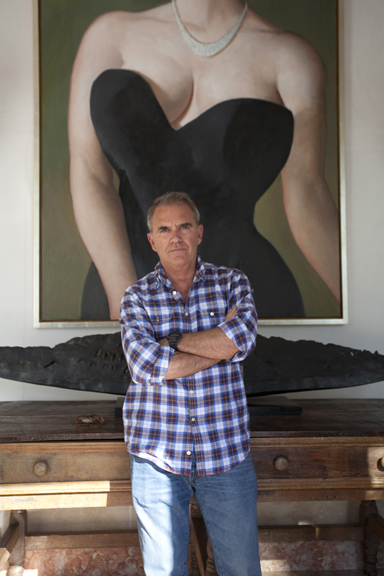 Accomplished painter, sculptor, and draftsman Julio Larraz through his artwork has transcended time and place for more than 50 years to become one of the most influential figures in Latin American and American art. Born in Havana, Cuba in 1944, Larraz is both a Cuban artist and an American artist. His foundation and love for art began to form during his youth and blossomed into an abundant career.
Accomplished painter, sculptor, and draftsman Julio Larraz through his artwork has transcended time and place for more than 50 years to become one of the most influential figures in Latin American and American art. Born in Havana, Cuba in 1944, Larraz is both a Cuban artist and an American artist. His foundation and love for art began to form during his youth and blossomed into an abundant career.
Julio Larraz’s father was a political activist and student who was imprisoned by the Machado regime for three years at the Isle of Pines. When he was released, he would go on to become the owner and editor of a newspaper in Havana, “La Discusion”. Larraz’s mother was a law student who later became the director of the family’s newspaper. In 1959, when Fidel Castro’s regime took control of Cuba, free press was extinguished immediately. With this new change the family realized that they would have to seek asylum in the United States; Julio Larraz was 16 years old.
The experience of being forced into exile and leaving his childhood home in Cuba had a profound effect on Larraz’s life and art. Before his physical exile, Larraz experienced some internal exile as well. As a child, Larraz spent most of his classroom hours perfecting his talents as an artist rather than attending to his schoolwork. He used school as a life drawing class in which he practiced his technique by creating caricatures and cartoons of teachers. Eternally energetic and full of imaginative impulsivity, he was expelled from several schools eventually landing in a military academy run by ex-officers of Fulgencio Batista. The combination of this ex-politically affiliated academy, followed by his eventual exile from Cuba, led to the development and motivation of Larraz’s caricatures. When asked of this introduction he said they “came naturally. [They were] natural, critical observations.” What he describes as more of a feeling than an observation, his caricatures grew in popularity due to their sense of humor, ability to portray each individual personality, and the skilled quality of his work.
Soon after arriving in the United States, he began to draw political caricatures that were published by the New York Times, The Washington Post, Vogue, Rolling Stone, Time, Ramparts, Newsweek, and The Chicago Tribune. The politics which forced him out of the country he loved would in turn carve and model the political undertones of his work. Aside from his well-placed caricatures, attributes such as the sea, imagery of people, faces, and locations have all weaved themselves into his work. He honed and sharpened his technique and the subjects of his work were influenced by the animosity he felt through the challenges and exploits he faced as a growing member of society. Through this journey, Larraz emerged as one of the world’s great painters.
Larraz was recognized professionally as a painter in 1971 with his first solo exhibition at the Pyramid Gallery in Washington, D.C. His work has since shown in galleries throughout the United States, Europe and South America. Larraz’s work has also been represented in numerous group exhibitions and can be found in many public and private collections. He has been the recipient of several awards from the Center for the Arts and Education, New York, NY; FACE, Miami, FL; the American Academy of Arts and Letters and the National Institute of Arts and Letters, New York, NY; and the Instituto de Educación Internacional, New York, NY. His omnivorous dedication to his craft has resulted in an enormous body of work spanning six decades, created in different mediums, and most importantly, contributing to the integration of Latin-American art culture.
In the 1980s, Larraz began experimenting with sculpture, a medium he took to almost immediately. Although he is not always remembered for his migration into the form of sculpture, he has created well known pieces which have graced public spaces, art galleries, and art fairs for years.
Since leaving Cuba, Larraz has lived and worked primarily in the United States, yet the time he has spent traveling has proven to be some of his most prolific. While living in Italy in the late 90s to early 2000s, he created countless watercolors that have added immense volumes to his collection. Larraz spent time living in New Mexico and Paris as well. These cities, landscapes and cultures also influenced and deepened his work, adding to the images he draws upon from within his deep imagination.
The development of Larraz’s work is based on many studies which he then builds into larger works. He borrows the appearance and expressions of people he encounters in his daily life and his travels and these faces often come to life in his work as characters from other worlds, other places, and other times. Larraz refers to this collection of ideas in his imagination as “The Kingdom We Carry Inside”. He speaks of his visions as dreams and describes being forced to do fast sketches in an attempt to capture them before they disappear. “They are like dreams, it’s like when you try to tell someone about a dream you had, and it becomes smoke before you finish the sentence”.
Larraz’s work combines the refinement of a skilled draftsman, and the narratives of a born storyteller, with the surreal distortion of a magician.
In 2004 Julio Larraz returned to Miami where he lives and works today.